
Europe and Mediterranean: Meze & Magic in the Mediterranean
Regent Seven Seas Cruises
Once serving as the capital of the Ottoman and Byzantine Empires, Istanbul today offers impressive architecture, historic sites, dining, shopping, nightlife and exotic atmosphere, making it a great place to begin your adventure. Then, sail along the Mediterranean until you get to Israel. Visit the land of miracles - Galilee, the Jordan River, the Mount of the Beautitudes and Tabgha, or venture to Nazareth, home of the young Jesus. See the largest hanging gardens in the world at the Bahai Gardens of Haifa. The Panorama Center in Central Carmel offers some of the country's best women's clothing stores. For antiques and crafts, head to the boutiques on Massada Street. South of Haifa, the artists' village of Ein Hod offers hand-blown glass, pottery, silver, gold, and crafts. From French to Continental to Middle Eastern cuisine, dining choices abound. Fresh fish and grilled lamb dishes are the highlight. The best dessert is homemade kanafeh, a traditional ancient dish of baked sweet cheese, pistachio and honey.

All onboard gratuities
Select complimentary shore excursions**
Unlimited beverages, including fine wines and premium spirits served throughout the ship
In-suite refrigerator replenished daily with soft drinks, beer and bottled water
24-Hour room service
No charge for specialty restaurants
Welcome bottle of Champagne
$100 Shipboard credit per suite††
Executive Member Benefit
Executive Members receive an annual 2% Reward, up to $1,250, on qualified Costco Travel purchases
Executive Members receive an additional $100 shipboard credit per suite (not combinable with certain past-guest discounts)††
Digital Costco Shop Card
Member Exclusive: Digital Costco Shop Card with every Regent Seven Seas Cruises® sailing†
Onboard the Seven Seas Voyager
Seven Seas Voyager
Year Built: 2003
Year Refurbished: 2016
Double Occupancy Capacity: 700
A trailblazer in the exclusive world of all-suite, all-balcony ships, Seven Seas Voyager® exceeds even the loftiest expectations for luxury. Considering her size, the amenities are surprisingly plentiful and include four main dining venues where you can dine wherever, whenever and with whomever you choose. With 447 international crew members attending to a maximum 700 guests, personal service is exceedingly indulgent throughout.
Activities & Services (included in cruise)
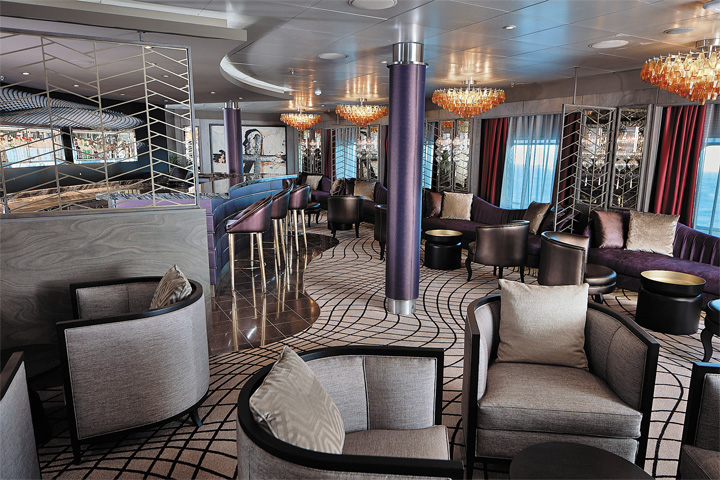
Lounge
- Card Room
- Disco/Nightclub
- Movies
- Fitness Center
- Sauna/Steam Room
- Educational Programs
- Pool - Outdoor
- Sports Facilities
- Whirlpool/Jacuzzi
- Bars/Lounges
- Library
- Wi-Fi
- Organized Age Specific Activities
- Teen Programs
- Business Center
- Concierge Desk
- Dry Cleaning/ Laundry Service
- Duty-Free Shops/Boutiques
- Elevators
Activities & Services (available for an extra fee)
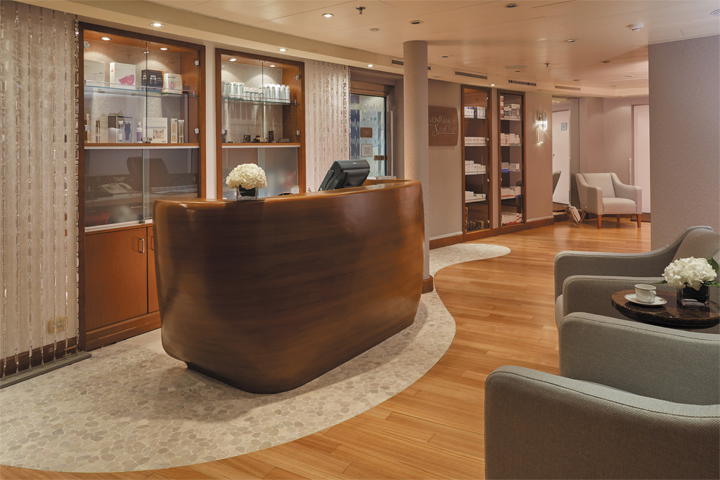
Full-Service Spa
- Beauty Salon
- Full-Service Spa
- Infirmary/Medical Center
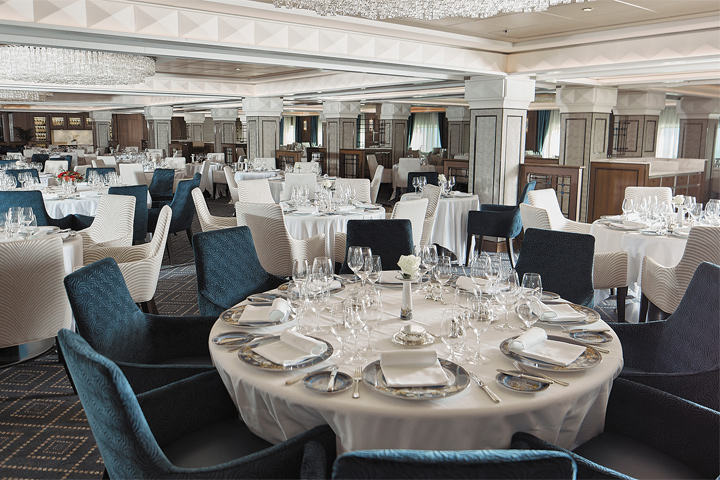
Compass Rose
Specialty Dining
Chartreuse: Featuring a classic French menu with a modern twist, Chartreuse evokes memories of a chic Parisian fine dining restaurant discovered during an evening stroll. Wherever you are seated in this regal restaurant, you will be treated to a succulent dinner while enjoying incredible ocean views. The restaurant ambiance is complemented by a menu that features dishes expertly prepared using both classic and modern techniques for a multiple course celebration of French gastronomy.
Compass Rose: Much thought was given to the design of Compass Rose, the flagship restaurant of Regent Seven Seas fleet. The dining room is outfitted with rich woods contrasted by light marble stones and mother of pearl shimmering brightly with an elegant color theme of light shades of blue, white, gold and silver. Compass Rose delights with a beautifully defined atmosphere and transitions from refreshing natural light during the day to a romantic ice blue lighting theme at night. This is the perfect setting for you to enjoy your breakfast, lunch and dinner, where the menu features an exceptional variety of Continental cuisine.
Prime 7: A true classic in every sense, Prime 7 sets a new standard in steakhouse fare with its contemporary interpretation of an American favorite. Handsomely decorated with supple leather wing-back chairs, burnished woods and rich earth-toned fabrics, Prime 7 exudes a distinct, intimate elegance. All the traditional starters are here, including Jumbo Lump Crab Cakes, Classic Steak Tartare, and Clam Chowder. Of course, beef is the undisputed star, and it is all USDA Prime and Dry-Aged at least 28 days to ensure the ultimate tenderness, juiciness and flavor. Prime New York Strip, Porterhouse Steak and succulent Filet Mignon only touch upon the selections. Mouthwatering alternatives include Alaskan King Crab Legs and Dover Sole. Prime 7 is open for dinner only and reservations are required.
Sette Mari at La Veranda: Each evening, La Veranda transforms into Sette Mari at La Veranda, a casual, intimate dining experience. Enjoy an extensive menu of authentic antipasti and Italian specialties served á la carte and paired with fine Italian wines — complimentary of course. Delectable dishes are prepared á la minute by talented chefs using only the freshest gourmet ingredients and served by attentive waiters. Sette Mari at La Veranda is open for dinner only.
Casual Dining
La Veranda Restaurant: Take in stunning ocean views while enjoying elegant breakfast and lunch buffets in the chic indoor dining room or al fresco on the shaded, open-air deck. Breakfasts include traditional favorites, as well as a made-to-order omelet station, a variety of fresh fruits and pastries, along with daily specials, like fluffy Belgian waffles with fresh blueberry compote. For lunch indulge in an array of choices from a bountiful salad bar, gourmet sandwiches, hot carving stations and delicious desserts.
Pool Grill: The Pool Grill is open-air, yet abundantly shaded for comfortable dining. Enjoy grilled-to-order burgers, grilled seafood, sandwiches, and fresh salads. Treat yourself to milkshakes and malts or an old-fashioned hand-dipped ice cream dessert sprinkled with all your favorite toppings.
Room Service: Complimentary 24-hour dining in the comfort of your stateroom.
Features a European king-size bed, a sitting area, a marble bathroom, a walk-in closet and a balcony. Concierge Level is available.

Category: H
Every inch of this suite has been thoughtfully designed to maximize interior space and embrace the magnificent scenery outdoors. From the sitting area, admire the ocean views through the floor-to-ceiling windows, or better yet, take a seat outside on your private balcony to watch the world go by. Elegant finishes such as luxurious bedding and beautiful marble detailing in the bath further enhance your comfort.
Suite size: 28.4 m²
Balcony size: 4.7 m²
Amenities:- Valet Laundry Service
- Unlimited Wi-Fi includes one log-in, one device, per suite*
- Welcome Bottle of Champagne with Fresh Fruit Arrangement
- In-Suite Mini-Bar Set-Up and Refill
- 24-Hour Room Service
- L'Occitane® Jasmin & Bergamote Soaps, Shampoos, and Lotions
- Regent Plush Bathrobes and Slippers
- Vanity and Hair Dryer
- Interactive Flat-Screen Television With Extensive Media Library, Complimentary Movies-on-Demand
- Direct-Dial Satellite Phone
- Shoe Shine Service

Category: G
Every inch of this suite has been thoughtfully designed to maximize interior space and embrace the magnificent scenery outdoors. From the sitting area, admire the ocean views through the floor-to-ceiling windows, or better yet, take a seat outside on your private balcony to watch the world go by. Elegant finishes such as luxurious bedding and beautiful marble detailing in the bath further enhance your comfort.
Suite size: 28.4 m²
Balcony size: 4.7 m²
Amenities:- Valet Laundry Service
- Unlimited Wi-Fi includes one log-in, one device, per suite*
- Welcome Bottle of Champagne with Fresh Fruit Arrangement
- In-Suite Mini-Bar Set-Up and Refill
- 24-Hour Room Service
- L'Occitane® Jasmin & Bergamote Soaps, Shampoos, and Lotions
- Regent Plush Bathrobes and Slippers
- Vanity and Hair Dryer
- Interactive Flat-Screen Television With Extensive Media Library, Complimentary Movies-on-Demand
- Direct-Dial Satellite Phone
- Shoe Shine Service

Category: F
Every inch of this suite has been thoughtfully designed to maximize interior space and embrace the magnificent scenery outdoors. From the sitting area, admire the ocean views through the floor-to-ceiling windows, or better yet, take a seat outside on your private balcony to watch the world go by. Elegant finishes such as luxurious bedding and beautiful marble detailing in the bath further enhance your comfort.
Suite size: 28.4 m²
Balcony size: 4.7 m²
Amenities:- Valet Laundry Service
- Unlimited Wi-Fi includes one log-in, one device, per suite*
- Welcome Bottle of Champagne with Fresh Fruit Arrangement
- In-Suite Mini-Bar Set-Up and Refill
- 24-Hour Room Service
- L'Occitane® Jasmin & Bergamote Soaps, Shampoos, and Lotions
- Regent Plush Bathrobes and Slippers
- Vanity and Hair Dryer
- Interactive Flat-Screen Television With Extensive Media Library, Complimentary Movies-on-Demand
- Direct-Dial Satellite Phone
- Shoe Shine Service
Spacious suites feature an in-suite iPad, daily canapés and upgraded bathroom amenities.

Category: A
The luxurious suite has been carefully designed to maximize space and comfort. Relax on your private balcony and indulge in your lavish bath amenities as you recharge and ready yourself for new adventures in the next port of call. This suite also includes priority online reservations for shore excursions and dining, and you're encouraged to call on the services of a personal butler for special requests.
Suite size: 29.7 m²
Balcony size: 4.7 m²
Amenities:- Valet Laundry Service
- 1-Night Pre-Cruise Hotel Package Including:
- Ground Transfers
- Breakfast
- Porterage
- Unlimited Wi-Fi includes up to four logins, four devices, per suite
- 15 Minutes of Ship-to-Shore Phone Time
- Guerlain & L'Occitane® Jasmin & Bergamote Soaps, Shampoos, and Lotions
- Personal Butler
- Welcome Bottle of Champagne with Fresh Fruit Arrangement
- Complimentary Pressing on First Night
- In-Suite Mini-Bar Set-Up and Refill
- 24-Hour Room Service
- Priority Online Shore Excursions and Dining Reservations
- 10% Discount on Premium Wine and Liquor
- 5% savings on Pre- or Post-Cruise Hotel or Land Programs
- 5% savings on Regent Choice Shore Excursions
- Selection of Bed Pillow Styles
- Regent Plush Bathrobes and Slippers
- Daily Canapés
- Personalized Stationery
- BOSE® SoundLink Mini II Bluetooth Speaker
- Binoculars, illy® Espresso Maker, and Cashmere Blankets
- Vanity and Hair Dryer
- Interactive Flat-Screen Television With Extensive Media Library, Complimentary Movies-on-Demand
- Direct-Dial Satellite Phone
- Shoe Shine Service
- Essentials Including Men's Unscented Shaving Kit, Facial Wipes, Sewing Kit, Emory Board, Stain Remover, and Hand Sanitizer
- Complimentary Tote Bag

Category: B
The luxurious suite has been carefully designed to maximize space and comfort. Relax on your private balcony and indulge in your lavish bath amenities as you recharge and ready yourself for new adventures in the next port of call. This suite also includes priority online reservations for shore excursions and dining, and you're encouraged to call on the services of a personal butler for special requests.
Suite size: 29.7 m²
Balcony size: 4.7 m²
Amenities:- Valet Laundry Service
- 1-Night Pre-Cruise Hotel Package Including:
- Ground Transfers
- Breakfast
- Porterage
- Unlimited Wi-Fi includes up to four logins, four devices, per suite
- 15 Minutes of Ship-to-Shore Phone Time
- Guerlain & L'Occitane® Jasmin & Bergamote Soaps, Shampoos, and Lotions
- Personal Butler
- Welcome Bottle of Champagne with Fresh Fruit Arrangement
- Complimentary Pressing on First Night
- In-Suite Mini-Bar Set-Up and Refill
- 24-Hour Room Service
- Priority Online Shore Excursions and Dining Reservations
- 10% Discount on Premium Wine and Liquor
- 5% savings on Pre- or Post-Cruise Hotel or Land Programs
- 5% savings on Regent Choice Shore Excursions
- Selection of Bed Pillow Styles
- Regent Plush Bathrobes and Slippers
- Daily Canapés
- Personalized Stationery
- BOSE® SoundLink Mini II Bluetooth Speaker
- Binoculars, illy® Espresso Maker, and Cashmere Blankets
- Vanity and Hair Dryer
- Interactive Flat-Screen Television With Extensive Media Library, Complimentary Movies-on-Demand
- Direct-Dial Satellite Phone
- Shoe Shine Service
- Essentials Including Men's Unscented Shaving Kit, Facial Wipes, Sewing Kit, Emory Board, Stain Remover, and Hand Sanitizer
- Complimentary Tote Bag

Category: C
The luxurious suite has been carefully designed to maximize space and comfort. Relax on your private balcony and indulge in your lavish bath amenities as you recharge and ready yourself for new adventures in the next port of call. This suite also includes priority online reservations for shore excursions and dining, and you're encouraged to call on the services of a personal butler for special requests.
Suite size: 28.4 m²
Balcony size: 7.4-12.7 m²
Amenities:- Valet Laundry Service
- 1-Night Pre-Cruise Hotel Package Including:
- Ground Transfers
- Breakfast
- Porterage
- Unlimited Wi-Fi includes up to four logins, four devices, per suite
- 15 Minutes of Ship-to-Shore Phone Time
- Guerlain & L'Occitane® Jasmin & Bergamote Soaps, Shampoos, and Lotions
- Personal Butler
- Welcome Bottle of Champagne with Fresh Fruit Arrangement
- Complimentary Pressing on First Night
- In-Suite Mini-Bar Set-Up and Refill
- 24-Hour Room Service
- Priority Online Shore Excursions and Dining Reservations
- 10% Discount on Premium Wine and Liquor
- 5% savings on Pre- or Post-Cruise Hotel or Land Programs
- 5% savings on Regent Choice Shore Excursions
- Selection of Bed Pillow Styles
- Regent Plush Bathrobes and Slippers
- Daily Canapés
- Personalized Stationery
- BOSE® SoundLink Mini II Bluetooth Speaker
- Binoculars, illy® Espresso Maker, and Cashmere Blankets
- Vanity and Hair Dryer
- Interactive Flat-Screen Television With Extensive Media Library, Complimentary Movies-on-Demand
- Direct-Dial Satellite Phone
- Essentials Including Men's Unscented Shaving Kit, Facial Wipes, Sewing Kit, Emory Board, Stain Remover, and Hand Sanitizer
- Complimentary Tote Bag
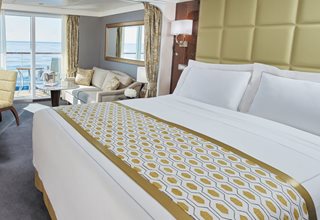
Category: D
In this superbly designed suite, you enjoy the comfort of richly furnished accommodations as well as exclusive luxuries available only in suites at the Concierge level and higher. Your suite includes amenities such as an illy® espresso maker and cashmere blankets, perfect for use in the morning when you wish to sip coffee and enjoy an in-suite breakfast on your private balcony. Take advantage of 24-hour room service when the mood strikes.
Suite size: 28.4 m²
Balcony size: 4.7 m²
Amenities:- Valet Laundry Service
- 1-Night Pre-Cruise Hotel Package Including:
- Ground Transfers
- Breakfast
- Porterage
- Unlimited Wi-Fi includes up to four logins, four devices, per suite
- 15 Minutes of Ship-to-Shore Phone Time
- L'Occitane® Jasmin & Bergamote Soaps, Shampoos, and Lotions
- Welcome Bottle of Champagne with Fresh Floral Arrangement
- In-Suite Mini-Bar Set-Up and Refill
- 24-Hour Room Service
- Priority Online Shore Excursions and Dining Reservations
- 10% Discount on Premium Wine and Liquor
- 5% savings on Pre- or Post-Cruise Hotel or Land Programs
- 5% savings on Regent Choice Shore Excursions
- Regent Plush Bathrobes and Slippers
- Binoculars, illy® Espresso Maker, and Cashmere Blankets
- Vanity and Hair Dryer
- Interactive Flat-Screen Television With Extensive Media Library, Complimentary Movies-on-Demand
- Direct-Dial Satellite Phone
- Shoe Shine Service
- Complimentary Tote Bag

Category: E
In this superbly designed suite, you enjoy the comfort of richly furnished accommodations as well as exclusive luxuries available only in suites at the Concierge level and higher. Your suite includes amenities such as an illy® espresso maker and cashmere blankets, perfect for use in the morning when you wish to sip coffee and enjoy an in-suite breakfast on your private balcony. Take advantage of 24-hour room service when the mood strikes.
Suite size: 28.4 m²
Balcony size: 4.7 m²
Amenities:- Valet Laundry Service
- 1-Night Pre-Cruise Hotel Package Including:
- Ground Transfers
- Breakfast
- Porterage
- Unlimited Wi-Fi includes up to four logins, four devices, per suite
- 15 Minutes of Ship-to-Shore Phone Time
- L'Occitane® Jasmin & Bergamote Soaps, Shampoos, and Lotions
- Welcome Bottle of Champagne with Fresh Fruit Arrangement
- In-Suite Mini-Bar Set-Up and Refill
- 24-Hour Room Service
- Priority Online Shore Excursions and Dining Reservations
- 10% Discount on Premium Wine and Liquor
- 5% savings on Pre- or Post-Cruise Hotel or Land Programs
- 5% savings on Regent Choice Shore Excursions
- Regent Plush Bathrobes and Slippers
- Vanity and Hair Dryer
- Binoculars, illy® Espresso Maker, and Cashmere Blankets
- Interactive Flat-Screen Television With Extensive Media Library, Complimentary Movies-on-Demand
- Direct-Dial Satellite Phone
- Shoe Shine Service
- Complimentary Tote Bag
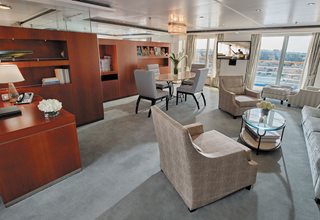
Category: SG
You'll find Park Avenue chic onboard Seven Seas Voyager® in this spectacular suite. Elegant rosewood furniture, luxe fabrics and a crystal chandelier create sophisticated comfort, while a personal butler is available to fulfill whatever requests you may have. With two bedrooms, two-and-a-half baths, a large living room and two private balconies, this sublime suite is perfect for hosting new friends in luxury.
Suite size: 107.0-113.0 m²
Balcony size: 17.0-17.4 m²
Amenities:- 1-Night Pre-Cruise Hotel Package Including:
- Ground Transfers
- Breakfast
- Porterage
- Unlimited Wi-Fi includes up to four logins, four devices, per suite
- 15 Minutes of Ship-to-Shore Phone Time
- Valet Laundry Service
- Choice of Guerlain, Acqua di Parma, and L'Occitane® Jasmin & Bergamote Soaps, Shampoos, and Lotions
- Guerlain Fragrance and Spongellé Buffer
- Personal Butler
- Priority Check-in on embarkation day with suite access at Noon
- Welcome Bottle of Premium Champagne
- Complimentary Pressing on First Night
- VIP Status to Include Dinner with a Senior Officer
- Welcome Letter from President and General Manager
- Complimentary Cocktail Party for 8
- Personalized In-Suite Full-Liquor Bar Set-Up
- 1 Sumptuous In-Suite Caviar Service
- Guaranteed Reservation Each Night in Specialty Restaurant of Your Choice†
- Complimentary 25-Minute Personal Fitness Session at the Serene Spa & Wellness™ Fitness Center
- 24-Hour Room Service with Specialty Restaurant Selections During Dining Hours
- Priority Online Shore Excursions and Dining Reservations
- 10% Discount on Premium Wine and Liquor
- 5% savings on Pre- or Post-Cruise Hotel or Land Programs
- 5% savings on Regent Choice Shore Excursions
- Selection of Bed Pillow Styles
- Selection of Fig and Tea Leaves Bath Salts
- Regent Plush Bathrobes and Slippers
- Daily Canapés
- Luxe Fruit Arrangement and Chocolate Leonidas
- Tea Forte Set-Up
- Personalized Stationery
- BOSE® SoundLink Mini II Bluetooth Speaker
- Complimentary Shore Excursion Bag
- Delivery of Up to Three Daily Newspapers
- World Atlas and Elegant Weather Clock
- Binoculars, illy® Espresso Maker, and Cashmere Blankets
- Bath Scale
- Vanity and Hair Dryer
- Interactive Flat-Screen Television With Extensive Media Library, Complimentary Movies-on-Demand
- Direct-Dial Satellite Phone
- Shoe Shine Service
- Essentials Including Men's Unscented Shaving Kit, Facial Wipes, Sewing Kit, Emory Board, Stain Remover, and Hand Sanitizer
- Complimentary Tote Bag
- 1-Night Pre-Cruise Hotel Package Including:
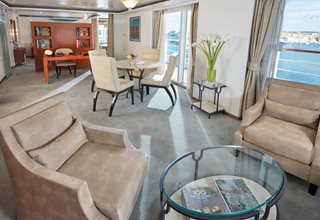
Category: GS
A suite so large it has two entrances, this suite delights the senses with rich mosaics, exotic woods, and luxurious touches. A living area with a couch and two comfortable chairs, a full dining table and large writing table make you feel right at home, while a leather chaise longue beside a jacuzzi feel like holiday indulgences. A large private balcony lets you welcome friends for a quiet dinner, and a personal butler helps make life at sea a breeze.
Suite size: 70 m²
Balcony size: 11.4 m²
Amenities:- 1-Night Pre-Cruise Hotel Package Including:
- Ground Transfers
- Breakfast
- Porterage
- Unlimited Wi-Fi includes up to four logins, four devices, per suite
- 15 Minutes of Ship-to-Shore Phone Time
- Valet Laundry Service
- Choice of Guerlain, Acqua di Parma, and L'Occitane® Jasmin & Bergamote Soaps, Shampoos, and Lotions
- Guerlain Fragrance and Spongellé Buffer
- Personal Butler
- Priority Check-in on embarkation day with suite access at Noon
- Welcome Bottle of Premium Champagne
- Complimentary Pressing on First Night
- VIP Status to Include Dinner with a Senior Officer
- Welcome Letter from President and General Manager
- Complimentary Cocktail Party for 8
- Personalized In-Suite Full-Liquor Bar Set-Up
- 1 Sumptuous In-Suite Caviar Service
- Guaranteed Reservation Each Night in Specialty Restaurant of Your Choice†
- Complimentary 25-Minute Personal Fitness Session at the Serene Spa & Wellness™ Fitness Center
- 24-Hour Room Service with Specialty Restaurant Selections During Dining Hours
- Priority Online Shore Excursions and Dining Reservations
- 10% Discount on Premium Wine and Liquor
- 5% savings on Pre- or Post-Cruise Hotel or Land Programs
- 5% savings on Regent Choice Shore Excursions
- Selection of Bed Pillow Styles
- Selection of Fig and Tea Leaves Bath Salts
- Regent Plush Bathrobes and Slippers
- Daily Canapés
- Luxe Fruit Arrangement and Chocolate Leonidas
- Tea Forte Set-Up
- Personalized Stationery
- BOSE® SoundLink Mini II Bluetooth Speaker
- Complimentary Shore Excursion Bag
- Delivery of Up to Three Daily Newspapers
- World Atlas and Elegant Weather Clock
- Binoculars, illy® Espresso Maker, and Cashmere Blankets
- Bath Scale
- Vanity and Hair Dryer
- Interactive Flat-Screen Television With Extensive Media Library, Complimentary Movies-on-Demand
- Direct-Dial Satellite Phone
- Shoe Shine Service
- Essentials Including Men's Unscented Shaving Kit, Facial Wipes, Sewing Kit, Emory Board, Stain Remover, and Hand Sanitizer
- Complimentary Tote Bag
- 1-Night Pre-Cruise Hotel Package Including:

Category: VS
Treat yourself to the welcoming luxury of a suite where elegance and comfort beckon in every nook. Open the sliding doors to your private balcony and inhale the fresh sea air. Enjoy your morning coffee at a cozy dining table or put your feet up in a soothing living room. Call on the services of a personal butler to assist with any needs and ensure that each moment of your journey exceeds your expectations.
Suite size: 51.5 m²
Balcony size: 4.7 m²
Amenities:- Valet Laundry Service
- 1-Night Pre-Cruise Hotel Package Including:
- Ground Transfers
- Breakfast
- Porterage
- Unlimited Wi-Fi includes up to four logins, four devices, per suite
- 15 Minutes of Ship-to-Shore Phone Time
- Choice of Guerlain, Acqua di Parma, and L'Occitane® Jasmin & Bergamote Soaps, Shampoos, and Lotions
- Personal Butler
- Priority boarding on Embarkation Day with Suite Access at 1:00 pm
- Welcome Bottle of Premium Champagne
- Welcome Letter from President and General Manager
- Complimentary Pressing on First Night
- Personalized In-Suite Full-Liquor Bar Set-Up
- Luxe Fruit Arrangement
- 1 Sumptuous In-Suite Caviar Service
- 24-Hour Room Service
- Priority Online Shore Excursions and Dining Reservations
- 10% Discount on Premium Wine and Liquor
- 5% savings on Pre- or Post-Cruise Hotel or Land Programs
- 5% savings on Regent Choice Shore Excursions
- Selection of Bed Pillow Styles
- Selection of Fig and Tea Leaves Bath Salts
- Regent Plush Bathrobes and Slippers
- Daily Canapés
- Personalized Stationery
- BOSE® SoundLink Mini II Bluetooth Speaker
- Delivery of Up to Three Daily Newspapers
- World Atlas and Elegant Weather Clock
- Binoculars, illy® Espresso Maker, and Cashmere Blankets
- Bath Scale
- Vanity and Hair Dryer
- Interactive Flat-Screen Television With Extensive Media Library, Complimentary Movies-on-Demand
- Direct-Dial Satellite Phone
- Shoe Shine Service
- Essentials Including Men's Unscented Shaving Kit, Facial Wipes, Sewing Kit, Emory Board, Stain Remover, and Hand Sanitizer
- Complimentary Tote Bag
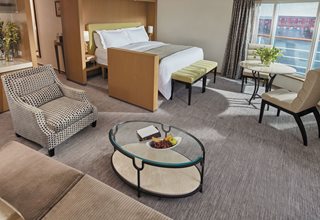
Category: SS
This suite is decorated with soothing colors, pleasing artwork, and comfortable furnishings. Relax in the sitting area after an exciting day ashore and enjoy the selection of fresh canapés delivered by your personal butler. Then retreat to your private balcony to watch the ever-changing vistas. In your glistening bathroom, marvel at the assortment of luxury bath soaps and shampoos as you ponder whether to use your tub or walk-in shower.
Suite size: 36.4-46.0 m²
Balcony size: 4.7-26.3 m²
Amenities:- Valet Laundry Service
- 1-Night Pre-Cruise Hotel Package Including:
- Ground Transfers
- Breakfast
- Porterage
- Unlimited Wi-Fi includes up to four logins, four devices, per suite
- 15 Minutes of Ship-to-Shore Phone Time
- Choice of Guerlain and L'Occitane® Jasmin & Bergamote Soaps, Shampoos, and Lotions
- Personal Butler
- Priority boarding on Embarkation Day with Suite Access at 1:00 pm
- Welcome Bottle of Champagne with Fresh Floral Arrangement
- Complimentary Pressing on First Night
- Luxe Fruit Arrangement
- In-Suite Mini-Bar Set-Up and Refill
- 24-Hour Room Service
- Priority Online Shore Excursions and Dining Reservations
- 10% Discount on Premium Wine and Liquor
- 5% savings on Pre- or Post-Cruise Hotel or Land Programs
- 5% savings on Regent Choice Shore Excursions
- Selection of Bed Pillow Styles
- Selection of Fig and Tea Leaves Bath Salts
- Regent Plush Bathrobes and Slippers
- Daily Canapés
- Personalized Stationery
- BOSE® SoundLink Mini II Bluetooth Speaker
- Elegant Weather Clock
- Binoculars, illy® Espresso Maker, and Cashmere Blankets
- Vanity and Hair Dryer
- Interactive Flat-Screen Television With Extensive Media Library, Complimentary Movies-on-Demand
- Direct-Dial Satellite Phone
- Shoe Shine Service
- Essentials Including Men's Unscented Shaving Kit, Facial Wipes, Sewing Kit, Emory Board, Stain Remover, and Hand Sanitizer
- Complimentary Tote Bag

| Symbol | Description |
|---|---|
 | Three guest capacity suite, convertible sofa bed |
 | Wheelchair accessible suites have shower stall instead of bathtub |
 | Connecting suites |
 | 2-bedroom suite accommodates up to 6 guests |
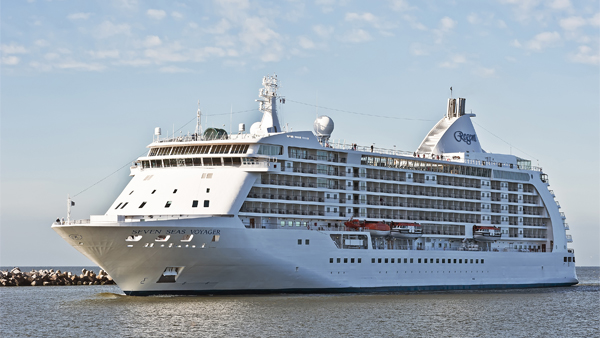
- Ship Name: Seven Seas Voyager
- Year Built: 2003
- Year Refurbished: 2016
- Year Entered Present Fleet: 2008
- Ship Class: Mariner
- Maximum Capacity: 700
- Number of Passenger Decks: 9
- Number of Crew: 447
- Officers' Nationality: International
- Tonnage (GRT): 42,363
- Capacity Based on Double Occupancy: 700
- Country of Registry: The Bahamas
- Total Staterooms: 350
- Suites with Balcony: 350
- Crew/Hotel Staff Nationality: European/International
Costco Member Reviews

Terms & Conditions
*Price shown is per person based on double occupancy, is valid for select stateroom categories only and does include government taxes/fees and gratuities. Click on the Terms & Conditions link below for details.
**Select complimentary shore excursions are for full-fare guests only, capacity controlled and subject to availability. Shore excursion reservations are accepted on a first-come, first-served basis. Please note, available excursions vary by sailing date and day of the week. Government fees and taxes are included. Requested excursions may not be available at time of booking. Supplement will apply on Regent Choice excursions and excludes Private Arrangements and all Adventures Ashore programs. Restrictions apply and penalties apply 36 hours prior to shore excursion start date.
††All shipboard credit is in U.S. dollars, is per stateroom based on double occupancy, has no cash value, is nontransferable and not redeemable for cash.
†One Digital Costco Shop Card per room/stateroom, per stay. The exact amount of the Digital Costco Shop Card will be calculated during the booking process. The Digital Costco Shop Card promotion is nontransferable and may not be combined with any other promotion. A Digital Costco Shop Card will arrive by email approximately 10 days after the start of your cruise. Click on the Terms & Conditions link below for additional information.
Ship's registry: The Bahamas
Digital Costco Shop Card
Book this vacation or cruise with Costco Travel and receive a Digital Costco Shop Card. The Digital Costco Shop Card is a convenient payment option in our warehouses and on Costco.com.







